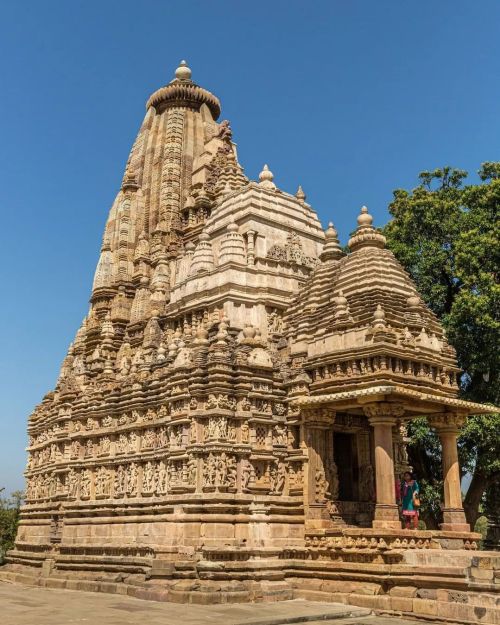#templesofindia
The Veerahbadreswara Temple located in the village of #Lepakshi in #Anantapur in #AndhraPradesh, is dedicated to the fierce Veerbhadra avatar of #LordShiva. One of the grandest temples of the Vijayanagara empire, it dates back to the 16th century and has been designated a monument of national importance by the Archaeological Survey of India. The naga linga sculpture is inside the Veerahbadreswara temple is about 15 feet tall and was supposed to have been carved out by a man in an hour.
#lepakshitemple #ancient #heritage #architecture #culture #instago #instatravel #andhrapradeshtourism #amazingandhra #templesofindia #everydayindia #indiaphototsociety #lonelyplanetindia #lpindia #travelindia #incredibleindia #indiaundiscovered #mypixeldiry #mysimpleclick #indianshutterexpress #sparklinghorizon #budpoi #indiafeature #Indianphotographyclub #hindustanblog
https://www.instagram.com/p/Cb62mjQPfYu/?utm_medium=tumblr
Post link
Built circa 960 C.E. during the reign of the Chandela king Dhanga and originally dedicated to Adinatha, Parshvanatha Temple is one of the finest Khajuraho monuments.
The temple is rectangular in plan, with an east projection containing the entrance porch, and the west projection housing a shrine attached to the rear of the sanctum.
The temple has an inner ambulatory, but unlike many other Khajuraho temples, it has no transepts with balconied windows. As a result, the outer wall of the temple is more solid, and the sculptors made maximum use of this blank canvas to apply their expertise.
Beautiful carvings adorn the temple exterior, in particular of apsaras caught in the act of activities such as applying eye make-up. Their voluminous nature, size, and poise, draws many parallels with the Lakshmana Temple (western group).
There’s also a vast array of vyalas with different heads, some of parrots, elephants, lions, and other creatures. The upper row of carvings is a little more animated, with varied scenes including flying figures and musicians.
Nobody is quite sure why this Jain temple contains so many images of Hindu deities on the outside wall, a theme also mirrored by the adjacent Adinatha Temple.
It is believed the earliest idol to be enshrined here was Adinatha. When Alexander Cunningham visited the temple in 1852 he found the main sanctum empty, and described it as merely “Jainatha Temple”. He also noted the temple was repaired by a Jain banker in 1847. 13 years later in 1860 a Parshvanatha idol was installed in the main sanctum.
An inscription (dated 954 C.E.) on the left door jamb of the temple records gifts and endowments of gardens by Pahila as a devotee of Jainism, and states that he was held in great esteem by king Dhanga.
The image installed in the shrine to the back of the sanctum is Adinatha, who the temple was originally dedicated to. I presume this a later installation as Cunningham made no reference to it in 1852.
Repost from @kevinstandage1
#khajuraho #khajurahotemples #incredibletemples #madhyapradesh #madhyapradeshtourism #mptourism #unesco #worldheritagesite #worldhistoricalmonuments #thegenuineindia #templesofindia #ParshvanathaTemp
https://www.instagram.com/p/Cc6vCvYPgM9/?igshid=NGJjMDIxMWI=
Post link
Eran (Sanskrit:ऐरण ) is a small village situated on the south bank of the river Bina, a tributary of the river Betwa, about 100km NE of the ancient sites of Vidisha, Sanchi and Udayagiri. Eran is probably one of the most ancient towns in India, coins and epigraphs found here give us it’s ancient names of Erakanya, Erakaina and Airikina and it was no doubt a significant stop on the ancient route from Vidisha to Mathura.
Excavations between 1960 and 1965 have revealed settlement deposits dating back to the second millennium B.C.E. However, the most significant archaeological finds from Eran has to be over 3,000 coins, dating from 300 B.C.E. through to 100 C.E. The most prevalent type of coins unearthed were square ones, and has contributed to archaeologists believing that Eran was once one of the ancient mints for Indian kingdoms along with Vidisha, Ujjain and Tripuri.
The principal Hindu monuments that can be seen at Eran today are all located in one small complex west of the town. There are the remains of four to five temples here, the main temples standing in a line on a north-south alignment at the far end of the entrance.
The Vishnu Temple houses an impressive image of Vishnu, 13 feet high and located in the temple sanctum.
This is the best preserved temple at Eran, and although the roof and walls are missing the decorated sanctum doorway is intact. The door jambs have images of Yamuna and Ganga, river goddesses that are typically found higher up in door jambs from the Gupta period. This has led some experts to believe that the doorway and front mandapa was installed during the Pratihara period, which would date those structures to the 8th or 9th century C.E.
Post Credit: @kevinstandage1
#eran #madhyapradesh #incredibletemples #madhyapradeshtourism #mptourism #worldhistoricalmonuments #thegenuineindia #templesofindia #incredibleindia #repost
https://www.instagram.com/p/Cc2yYKhvWXN/?igshid=NGJjMDIxMWI=
Post link



